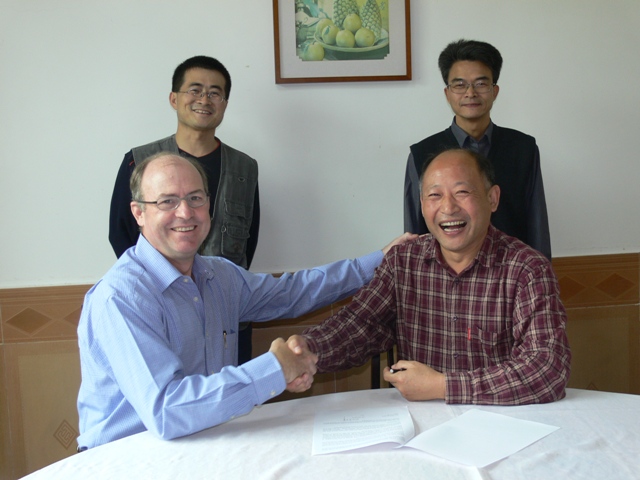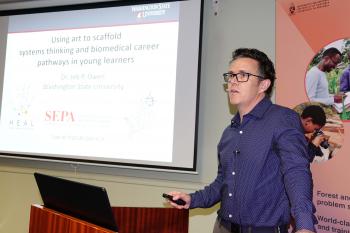 |
Former president of the Chinese Academy of Forestry, Madam ZeHui Jiang's visit to SA where FABI linkage was also forged. |
The Forestry and Agricultural Biotechnology Institute (FABI) includes a research programme that represents the world's single largest team investigating pest and pathogen problems affecting plantation-grown forest trees, particularly those in the tropics and southern hemisphere. During the course of the past 20 years, this research team in South Africa has been working extensively to support forestry companies in South Africa as well as those from other parts of the world. In addition to greatly contributing to tree health and sustainable management of forestry through their research, a very substantial base of new knowledge has been generated on diseases and pests that damage forests and threaten the sustainability of forestry. Work has been published extensively in the international literature and students from many different parts of the world have benefited from post graduate education in the field of forest protection.
The China Eucalypt Research Centre (CERC: http://www.chinaeuc.com/enDefault.aspx) is the primary organization working on Eucalypt breeding in China and it plays an essential role in supporting the Eucalypt plantation industry in China. CERC also serves as the headquarters of the China Eucalypt Society and China Eucalypt Breeding Alliance. The research team of the Centre holds first hand knowledge and information regarding Eucalypt plantations in China, and has published a large number of papers nationally and internationally on this topic.
 |
Signing a Memorandum of Understanding by Mr. JieFeng Liu (Director of CERC) and Prof. Mike Wingfield (Director of FABI). |
During the course of the last four years, through exchange visits as well as via two inter-governmental research initiatives between South African and China, FABI and CERC have come to develop close research links. These linkages have been deepened through various exchange visits. Thus, in 2003 and 2005, Prof. YaoJian Xie of CERC and his colleagues visited FABI as well as other South African forestry industry players. Likewise, Dr. XuDong Zhou from FABI paid a return visit to CERC in 2004 as part of a process of forging future collaborative initiatives. More recently, Prof. Mike Wingfield, director of FABI, visited CERC and Chinese Eucalypt plantation companies. These exchanges have led to deepened commitment to collaborate in the field of Tree Health Biotechnology.
CERC and FABI are both committed to promoting an enhanced understanding of the threat of pests and pathogens to forest plantations. They especially recognize the benefits that will come from collaboration and sharing knowledge pertaining to pests and diseases threatening the sustainability of plantations in China, South Africa and elsewhere in the world. Efforts to understand the biology and spread of these pests and pathogens will clearly be of great benefit to both institutions and industries that they support. Based on this realisation, the two institutions have agreed to establish a new Programme known as the CERC-FABI Eucalypt Protection Programme (CFEPP). The primary goal of the CFEPP will be to study Eucalyptus diseases and pests that threaten plantation development in China.
The CFEPP will be directed by Dr. XuDong Zhou. In this initiative, he will be guided by Profs YaoJian Xie and Mike Wingfield. The two parties are committed to seeking further funding to promote their collaboration. Thus far, the Chinese Academy of Forestry (CAF) has provided seed funding for Dr. Zhou. Furthermore, Profs Mike Wingfield and YaoJian Xie have jointly secured funding from an inter-governmental project between South African and Chinese Governments. This project, "Fungal diseases threatening Eucalypt plantations in China", forms an integral part of the CEFPP.










































